This is a plant ID I posted 4 1/2 years ago. As some readers may have noticed, I uploaded many plant IDs in July 2013, but took down more than half of them about a week later because I was eager to solve the VMS and felt I might be giving too much away, but since the VMS has not yet been solved, as of Feb. 2018, I’ve had a change of heart and have decided to post them again as I have time. I haven’t changed the original text because I haven’t seen anything in the interim that alters my opinion about this plant.
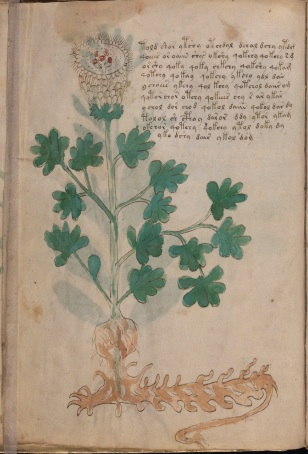 Description
Description
Plant 18v features a large drawing occupying most of the page. There is a ten-line block of text to the right at the top.
The stalk is quite upright and lightly painted. The leaves are a fairly solid green and fan-like, with about six rounded tips per leaf. The way they are attached to the stalk is variable—sometimes alternate, sometimes opposite. Some plants are like this, but most tend to lean toward one or the other.
The root has two sections, more bulbous near the stalk, with a long rhizome at the base. It is selectively painted a light reddish-brown and includes a long “tail” that might be characteristic of the plant (some plants have extended rhizomes that are more slender) or which might be symbolically related to the identity of the plant. There are protrusions from the rhizome shaped a bit like a caterpillar.
Prior Identifications
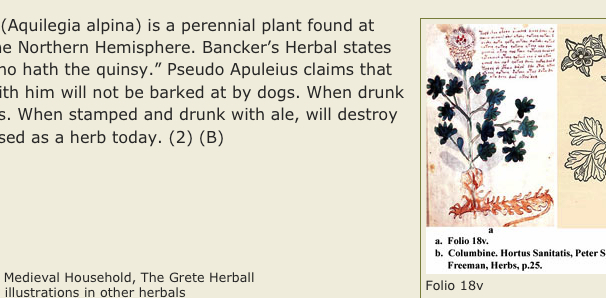 Edith Sherwood has identified this as columbine (Aquilegia alpina), perhaps because colombine leaves are somewhat fingerlike, but I don’t think it’s a very good fit. Colombine leaves do fan out, but they are also trifoliate, which the VMS leaves are not, and colombine does not have an elaborate, extended, branched style/pistil. In fact, one of the distinctive characteristics of colombine is that the flowers nod and have spurs extending toward the sky, something that is not expressed in any way in the VMS drawing.
Edith Sherwood has identified this as columbine (Aquilegia alpina), perhaps because colombine leaves are somewhat fingerlike, but I don’t think it’s a very good fit. Colombine leaves do fan out, but they are also trifoliate, which the VMS leaves are not, and colombine does not have an elaborate, extended, branched style/pistil. In fact, one of the distinctive characteristics of colombine is that the flowers nod and have spurs extending toward the sky, something that is not expressed in any way in the VMS drawing.
Other Possibilities
I only have a few candidates for Plant 18v and I’m not satisfied that the first three are close enough, but I’ll mention them, for the record:
- Plant 18v leaves are very similar to Lady’s mantle (Alchemilla vulgaris), a plant with a woody rhizome included in many herbal manuscripts, but if the VMS depicts Alchemilla, then the tiny clusters of flowers have been greatly magnified and modified. It doesn’t seem likely that Alchemilla flowers would be drawn this way. VMS Plant 23r is much more similar to Alchemilla than 18v—with fingerlike leaves, branching flower clusters, and the thick matted growth pattern clearly expressed in Plant 23r.
- There is also a species of Convolvulus (known to many as morning glory or bindweed) that has fingerlike leaves and a number of protrusions within the petals, but unlike the VMS drawing, it’s a viny plant that grows lower to the ground, and the style/pistil doesn’t resemble the VMS drawing.
- Geranium molle (dove’s-foot cranesbill) also has fingerlike leaves, but the leaves are more elaborate than the VMS and, like Convolvulus, the plant is somewhat viny and low-growing. Geranium molle does, however, have a branched style/pistil with little knobs on the end (I prefer to stay away from botanical terms because “knobs” are not always stigmas and anthers), so perhaps it’s not unreasonable to keep Geranium molle as a possibility, but it’s not at the top of my list because the overall shape of the plant and complexity of the leaves is dissimilar to Plant 18v.
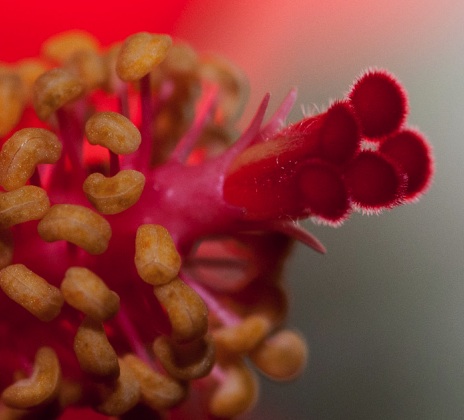
Some species of hibiscus have five distinctive rounded red enlargements at the end of the pistil. [Image detail courtesy of Jawahar Swaminathan]
Different species of hibiscus have somewhat variable leaves, but quite a few of them have fan- or hand-shaped leaves.
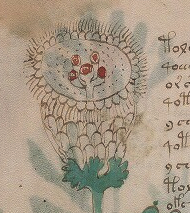 If you peel away the petals on Althea (Malva), the plants commonly called hibiscus and hollyhock, the pistils of some species might be drawn like Plant 18v, and the leaves are a pretty good match as well. On some species the red knobs are close together, as in the photograph above, and in some they are splayed apart, as in the VMS drawing.
If you peel away the petals on Althea (Malva), the plants commonly called hibiscus and hollyhock, the pistils of some species might be drawn like Plant 18v, and the leaves are a pretty good match as well. On some species the red knobs are close together, as in the photograph above, and in some they are splayed apart, as in the VMS drawing.
Althaea rosea, a hollyhock that grows in the Balkins, has a long row of protrusions along the pistil, similar to a bottlebrush. The leaves are palmate, but not quite as fingerlike as Plant 18v.
Malva maritima has more fingerlike leaves, and quite an elaborate style/pistil attachment with a starlike whorl of five leaflets. It also has protrusions at the end of the style/pistil, but does not have the very distinctive red matchstick-like ends protruding beyond the fuzzy parts that we see in the VMS drawing.
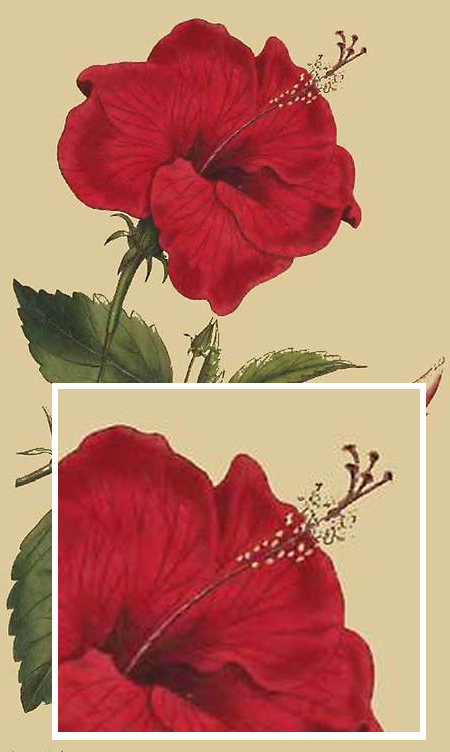 Hibiscus rosa-sinensis (left), a hibiscus that grows in Malaysia, has a particularly distinctive protrusion, with five branching knobs and a bottlebrush spray. The ends are bright red, as in the VMS drawing, but H. rosa-sinensis does not have fingerlike leaves, they are elliptical, so it’s not quite a match.
Hibiscus rosa-sinensis (left), a hibiscus that grows in Malaysia, has a particularly distinctive protrusion, with five branching knobs and a bottlebrush spray. The ends are bright red, as in the VMS drawing, but H. rosa-sinensis does not have fingerlike leaves, they are elliptical, so it’s not quite a match.
Malva neglecta has more fingerlike leaves but lacks the five distinctive red bulbs at the end of the style.
As with many VMS drawings, it’s hard to narrow it down to a single species, but Althea/Malva strikes me as being more similar to the VMS drawing than other kinds of plants and the distinctive five-branched style/pistil is not common in the plant world and thus is a good detail for remembering the plant.
I did find one other plant with a similar pistil, split into several bulbous ends, but the leaves were not a good match for the VMS, so I’m leaving it on the backburner for now.
J.K. Petersen
P.S.: The New World passion flower has a distinctive branching style/pistil, but the plant, as a whole, tends to be more viny than the VMS plant drawing, has variable numbers of branches on the style and doesn’t usually have the distinctive matchstick-like red knobs as are found in hibiscus. Also, the leaves of most species of passion flower are trifoliate and those that are more fingerlike don’t quite have a fan shape, each leaflet is usually more separate from the others. The fruits of passion flower are also quite distinctive and are frequently included in botanical drawings and the VMS plant doesn’t include fruit.
For those interested in botanical history, the passion flower was thought to be a species of clematis for a couple of centuries after the New World was colonized by Europeans. They do look similar in a number of ways, but Clematis is actually more closely related to the buttercup (Ranunculus) than to the Passiflorae.
